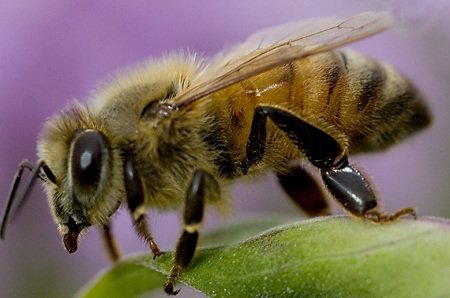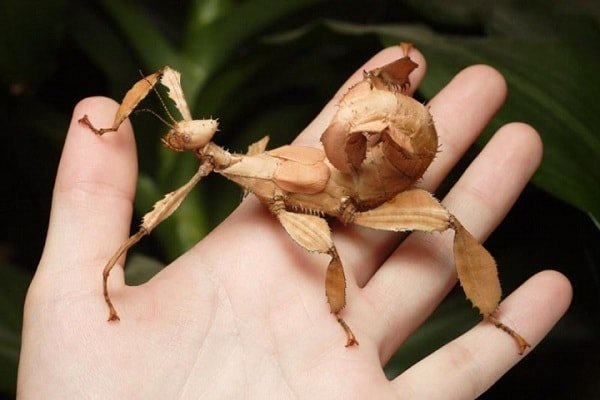India has a diverse flora and fauna and it is a home to various kinds of insects. These little living beings are also important for the nature. Basically, insects help disposal of wastes whose accumulation will be detrimental for our environment. Insects binge on dead animals and plants so that their mess could be cleaned up.
However, these little creatures are considered the most incompetent in the food chain.
Given below is the Top 15 Amazing Insect Species found in India in the order of their importance:
1. Honey Bee

It is one of the most amazing species found in India. Primarily because of its nature to produce honey which humans are using since time immemorial. Honey is used as a healing agent and many women use it as a beauty product. Various kinds of bees found in India are Rock bee, Indian Bee and Little bee. Also honey bees are significant for environment as it helps in Pollination. It is said that if all the bees in this world cease to exist, human race will come to an end in just 4 years.
2. Butterfly

They are admired because of their colorful wings, these insects are usually found during daytime and are given a high regard in terms of grace, attractiveness and somberness. The head of the butterfly bears two large compound eyes, filled with many ommatidia, a pair of club-shaped antennae, two pairs of large wings characterize the butterfly. These equal-sized wings are held high over the body at the times of rest resembling sails of a boat. Each category of this beautiful insect has fondness for a specific shrub to lay offspring. The larvae are called the caterpillars which sheds it old cuticle – skin – and becomes fully-grown in 15 days. After which a covering is produced around its body called Pupa. This is basically produced from the secretion from the caterpillar’s body. Once the Pupal case is broken the butterfly emerges and the process completes.
3. Lac Insect

The Two common species under this genus is —Lacca and Chinenses. Of these,Lacca is the most commonly found insect in India. India is the topmost country for producing lac. Basically these insects have a habitat on specific trees like kusum, khair and ber. It releases a sticky product which creates a coating round them. From which a thing called lac is acquired. Lac has a great marketable value. It is used in Lithographic ink, Varnishes and polishes, Sealing wax, making ornaments, toys etc. is completed. The body remains soft, for some time after breaking of this Pupa.
4. Ants

There are nearly 3,500 species of ants which either habitat in burrows or formed nests especially for habitation. The abdomen is clearly separated from the middle section of the body. They forms colonies and are specified as Queens, Kings, Soldiers and Workers.The famous categories of ants found in India are the common red ant and the black ant. They usually are disastrous for the vegetation but are effective pollinating mediators. Numerous ants kill caterpillars, bugs and beetles and consequently serve as significant role in biological control.
5. Lady Bird

These beautiful insects are important in destroying aphids and other pests that grow on plant. Their bodies are red-colored and have black spots on it. They are commonly found all over the world and are generally taken as very useful insects, because they prey on agricultural pests such as scale insects or aphids. They lay their eggs right on the aphid and scale insect clusters to ensure their larvae have an instant food source after hatching.
6. Fireflies

These insects are predominantly known for their capability to radiate light. They are soft bodied and are brown in color.It is possible because they own suchorgans which help in light emission after exposure to radiation. These phosphorescent organs are present in the abdominal part along with an element Luciferin, which is oxidized in the presence of an enzyme luciferase to emit light which is deprived of heat.
7. Dung Roller

They are widely known as Dung beetle and notably these were well-thought-out as sacred in ancient Egypt. They make small balls by rolling dung and females lay eggs on these balls which are later accumulated in a hole. When the larvaoriginates out it uses this dung as food. A fact is that in one night a dung beetle can bury dung 250 times bulkier than itself.
8. Wasp

Well- known wasps are Spider wasps and Hornets. The spider wasps are large in size, very active, long-legged and usually hunt spiders. They construct underground dens and keep a paralyzed spider in it and eggsare laid on each of them so that when they hatch, the larvae consume the spider.The hornets on the other hand live on sugary fluid like nectar and ripe fruit and consume larvae and other little insects.
9. Common Windmill

The scientific name of this beautiful velvety black coloured butterflies Parities Philoxenus and commonly found in the Himalayan region particularly in Assam. They are notably smaller size. The frontal wings are horizontal but subsequent wings are unusually uneven and also possess attractive red spots.
10. Stick and Leaf Insects

Some insects have the bodies that look like branches and leaves of the trees. Such imitation is to safeguard them adversaries. There is a long list of such insects like Diapheromera, Carausius, Praying Mantis and Leaf Insect The females’ exhibit more accurate mimicking features than males. In general, these insects are large-sized, herbivorous, have distinctive eyes and multi-jointed antennae. Stick insects adopt a tree branch-like appearance. Leaf insects have the wings and other parts like a leaf. Even their look like seeds and newly produced also mimic. Praying Mantis is a huge insect named because its front legs are bent like in the position of prayer. This beautiful insect can be domesticated and it is a remarkable predator of the mother-nature.
11. Bed Bug

These blood-sucking parasites habituate closer to mankind and exhibit cosmopolitanism. Bed bugs are a cause to a number of diseases like anthrax, oriental sore & leprosy paratyphoid. They are generally found in the bed, furniture and gaps of every possible place in the house. They are very active during the night and get attracted by the warmth and smell of the host body.
12. Louse

There are three kinds of lice—Book-lice, Biting lice and Sucking lice and these three include numerous kinds of species. They are tiny and soft-bodied bugs which have an unusual biting mouth. They abode on trees and within old papers and also as parasites.
13. Krishna Peacock

These huge butterflies are also known as Papilio Krishna with wingspan of over 10 cm. Their enormous wings have stunning green texture with red, blue and yellow markings. They are commonly found in the Himalayan region of India, especially Sikim. The subsequent wings are uniquely lobed.
14. Kaiser-I-Hind

These butterflies of Assam, Nepal and Sikim are very rare and unveil different features outside the dissimilarities in their sexual organs. Females have three tails but male flies have one. They usually abode on the top of the sapling and very rarely descend to the ground.
15. Rice Butterfly

These butterflies are quite common in India and can be distinguished from their deep brown color. They lay eggs on rice plants and have distinguishing colored eye spots at the middle of their wings. The caterpillars are green resembling the rice plant like color.
Conclusion
In reality, most insects are beneficial to humans and the environment. Most of the plants depend on insects to carrying their pollen to other florets. Pollination is a very important facilities provided by insects.Half of them are plant-eaters, gorging on leaves, roots, seeds, nectar, or wood. Some insects are predators while some are alive on eating the flesh or blood of larger animals without killing them.
I’m Hina Khan, working as a writer at Worldblaze.in blog. I love dancing and listening punjabi music. Here I’m sharing all the interesting stuffs that will definitely entertain you.
